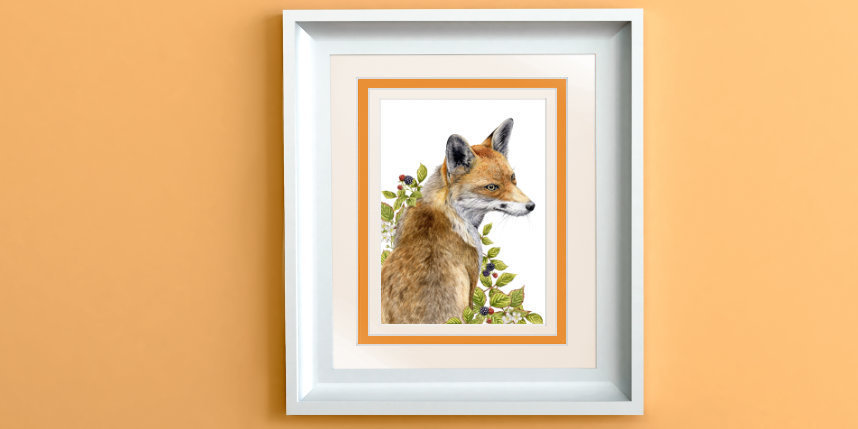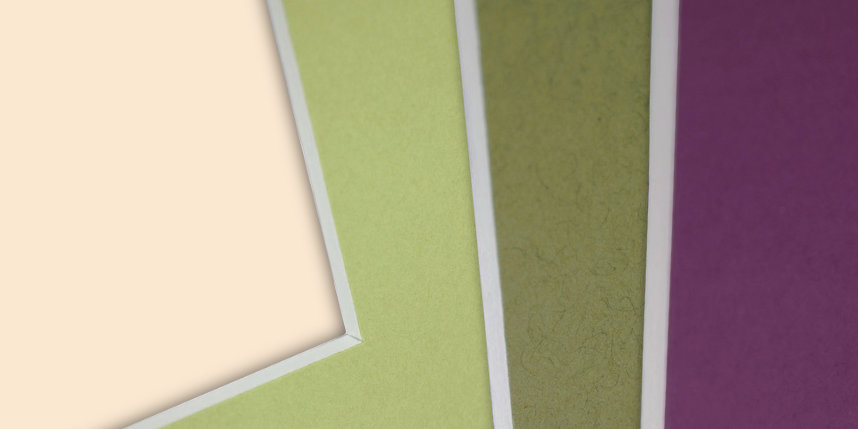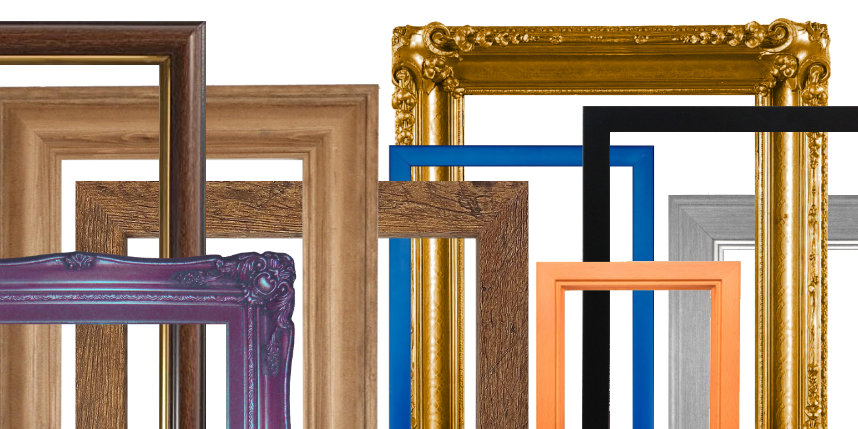I am often asked how to choose picture frames for watercolour art that people have purchased. Unfortunately it is one of those problems that comes down to personal taste and the environment that the art is to live in. However I have put together a few of my thoughts on the matter in the hope that it will help someone who needs some advice on framing wildlife and nature illustrations.

To begin, the advice here is based on my experience of framing the kind of art I produce - watercolour, pen and ink or graphite nature and wildlife art - but it can also be used for other art types or when framing pastels, charcoal or gouache paintings. Oil and acrylic paintings have their own ways of framing but you can find out more about that with a quick online search.
1. Professional picture framers
I always suggest that customers go to a proper picture framer to get help and advice with framing artwork. They have the skills and experience to help you choose the right mount, frame and even glazing options. However it is not a cheap option when you compare it to buying a low cost frame online or from large Scandinavian retailers - but you should get a much better quality frame and overall experience. If you do not know of a good local framer then you can find one in the UK via the Fine Art Trade Guild, where each framer has to meet standards set out by the guild in order to be a member.

If you would rather choose your own frames and mounts then read on for some hints and tips.
2. Mounts
First of all you need the painting or drawing to be placed in a mount. A mount is a piece of smooth or textured card (mountboard - or 'mattboard' in the USA) with a window (or aperture) cut in it. This keeps the glass off the surface of the painting or drawing so it does not get damaged. It also creates the effect of looking into a painting by forming an extra frame to focus the attention on the art. The mountboard should be 100% acid free - this means that the mountboard is pH neutral and stops the breaking down of the art paper due to acid leaching out of the mountboard.

Single or double mounts
Mounts can be single - one layer of mountboard - or double - two layers. I have also seen triple mount that are very striking, especially when the layers are different sizes instead of the same size between them (see the example in the 'Framing ideas' section below). A 'wash line' (a pen or pencil line that surrounds the window) can also be used around the aperture to add a bit of extra detail (see the framed picture of the barn owl above for an example).
A single mount is best used for small pieces or prints. A little painting in a small frame surrounded with an ivory mount sets the painting off without it being overwhelmed.
Double mounts can be used on large or small pieces. If using two colours of mountboard to form the mount, there is a thin line of colour, 3 to 10 mm thick around the painting. It is formed by the aperture in the top mount being cut slightly larger than the one in the bottom layer. It is a very effective way of mounting, giving more emphasis to the art. It gives large paintings a really nice finish and can add interest to a small one.
These days a double mount in ivory or off-white is popular too. It is clean and uncluttered and preferred by some as it gives a more subtle effect.

Colours
You can find mountboard in a variety of colours, from neutrals through to strong, vibrant colours. A good all round choice is cream or off-white. Both are traditional and will compliment most colours in a piece of art rather than competing with it.

For other colours, the choice of mountboard often reflects that colours in a piece of art. For example, a pen and ink piece might have a double mount with a white or ivory top mount and a black bottom mount. Cream and charcoal grey mounts might work nicely for graphite work. A watercolour sea scape might have a pale blue top mount and a deep blue bottom mount.
If you choose a dark or strong coloured mount against the art (either in a single or double mount) it gives a crisp edge that butts up against the art. In turn this draws attention to the work by creating contrast between the mount and art.
You can always choose a really brightly coloured mount too. In order to make a real statement piece for your wall, picking something like a scarlet or burnt orange with a brightly coloured watercolour can be very striking.
3. Glass
Glass for glazing art work can be plain glass, non-reflective glass, conservation grade, museum grade and even acrylic (which also comes in museum grade that does not scratch). As a basic choice for large pieces you will probably want non-reflective glass as it stops the glare from sunlight.
At this point it should also be mentioned that you don't want to be hanging art in direct sunlight either. Even the most robust art materials get jaded by direct sun after a while. Also, don't hang art over a heat source like a heater or oven. I learned that piece of advice from experience.
However if you are buying a frame from an online retailer chances are that you won't get a lot of choice in the matter. Ordinary glass without non-reflective qualities does the same job - to protect the art from everyday damage from dust and moisture. For small pieces the choice of non-reflective glass is less important as it has less shiny surface are to catch the light.
4. Frames
In my experience there are two main formats that people like to use when buying frames - a wide mount with a narrow frame or a narrow mount and a wide frame. This is not exclusive, of course, but it is a good thing to bear in mind when making framing choices.

Picking the style of frame is very subjective. People have their preferences due to personal taste as well as what their lived environment is like. To make things more complex, we have a wide variety of frame options available these days - plain, carved, smooth, moulded, painted, lime washed, gilt, natural, wood, acrylic, vibrant, monotone, two tone.... You might prefer something traditional with a moulded gilt frame or something modern with a white frame and mount.
A few framing ideas
If trying to decide is making your head hurt though, black or white frames are always a good bet. However I have a few suggestions for the art I make that might be helpful:

Watercolour paintings:
- A wide, plain, natural wood frame and a double mount (ivory on top with a bottom mount in a corresponding colour) shows off illustrations of natural objects nicely.
- A thin, pale wood frame with pale coloured double mount works nicely for paintings with strong colours.
- A traditional, slender, dark wood moulded frame with gold accents is still popular with a lot of clients. Combined with a double mount it gives a sense of tradition and class.
Pen and Ink:
- A sleek, plain black frame with a single off-white mount for small pieces.
- A gold moulded frame with cream single or double mount adds a little glamour.
- A glossy, black moulded frame with a full black or charcoal double mount for something very striking. This works best if there is plenty of white in the artwork.
- A white frame with white triple, double or single mount.
Graphite:
- A matt, dark grey or black frame with white mount.
- A light grey frame with charcoal mount.
- A gold frame with triple mount in subtle, vintage colours, e.g. ivory and muted greens or dusty blues. This works well with small square pencil drawings, especially if the drawing is on toned paper.
